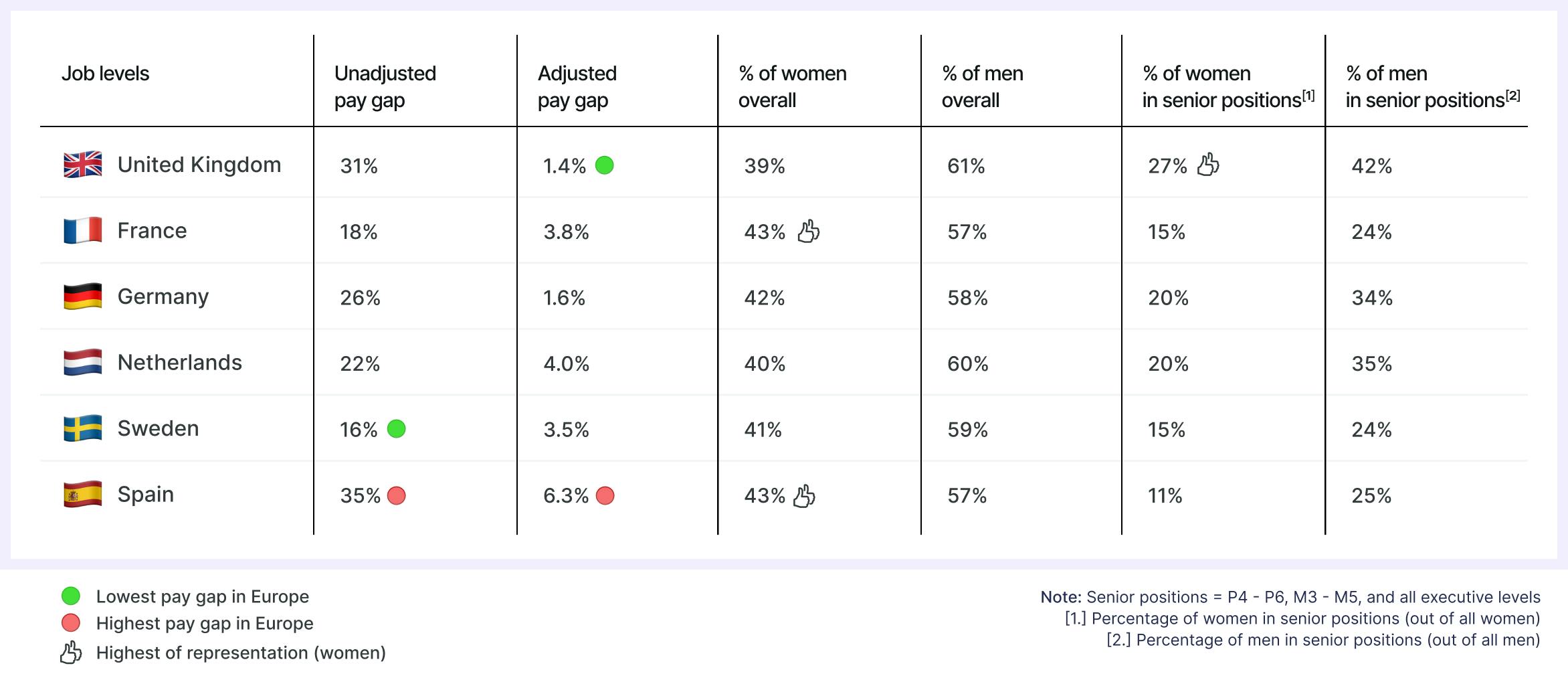- What is a gender pay gap?
- Why is there a gender pay gap in European tech?
- Cause of gender pay gap #1: Representation (there are less women in senior positions than men)
- Cause of gender pay gap #2: Hiring practices introduce a pay gap at the point of hire
- Cause of gender pay gap #3: Women still juggle raising a family with career progression
- Effects of the gender pay gap
- How to fix the gender pay gap issue
Ravio’s recent pay equity report shows that the gender pay gap isn’t as simple as a gap in wages between men and women. There are different ways to measure the gender pay gap, such as unadjusted and adjusted. And there are various drivers of the gender pay gap outside of just salary differences, such as representation.
Certain countries are doing better than others when it comes to pay equity in tech. The UK and Germany have the lowest adjusted pay gaps, while Spain and The Netherlands have the highest.
But no matter how you look at it, there is still a gap across the board. The tech industry has a long way to go when it comes to achieving gender equality and pay equity.
In this blog post, we’ll explore why there is a gender pay gap in European tech, what causes it, and some actionable tips to help improve – and close – the gender pay gap in your organisation.
What is a gender pay gap?
The gender pay gap refers to the difference in salary earnings between men and women. Depending on what gender pay gap you are looking at, it can either explain the gap between men and women overall, or it can explain the difference between men and women through a more specific lens.
These are widely known as the unadjusted and adjusted pay gaps:
- The unadjusted pay gap, offering a birds-eye comparison of all men and women
- The adjusted pay gap, offering a zoomed in, like-for-like comparison between men and women specifically in the same role and level
Why is there a gender pay gap in European tech?
Organisations must report their gender pay gap to comply with legislation, such as the EU Pay Transparency Directive. There is also a growing expectation that companies, especially those in tech, communicate their compensation policies transparently with employees.
Yet, despite external pressures, a gender pay gap still remains in the tech industry across Europe. Why? Here are 3 key reasons why there is a gender pay gap in tech today.
Cause of gender pay gap #1: Representation (there are less women in senior positions than men)
The biggest driver of the unadjusted gender pay gap is representation. Across the majority of countries, functions, and levels, there are more men than women. This is especially true of senior positions, where the proportion of women drops off dramatically compared to men and lower positions.
This is the crux of the pay equity issue in 2024: with more men earning higher salaries than women, it drives up the unadjusted pay gap which currently sits at 25% across Europe.

It also highlights a distribution problem across European tech. Not only are there less women than men across the board, but there is an unbalanced distribution of women across ranks. meaning that the number of women significantly drops as they gain seniority. According to the World Economic Forum, only 10% of Fortune 500 companies have female CEOs.
Cause of gender pay gap #2: Hiring practices introduce a pay gap at the point of hire
Ravio data from our pay equity report found that where there is a gender pay gap present, it is usually introduced at the point of hire. One reason could be because women tend not to negotiate a higher salary when interviewing, although there is conflicting research to support this. The more likely reason is unconscious bias in hiring practices, which can allow a pay gap to be introduced at the point of entry.
Let’s look at one particular role to demonstrate this. Using Ravio’s levelling framework, a female, level 4 software engineering professional in the UK will earn 3.3% less than her male counterpart for exactly the same work. This is evident across many roles that we’ve seen in Ravio’s database.
It’s clear that there is room for improvement in hiring practices. Whether it’s having reliable data to ensure that men and women are consistently offered the same compensation. Or training to remove any hiring biases that might be introduced from individuals in the interview process.
“Companies must really dig in and make sure they’re paying attention to fixing any hiring bias that might be occurring, as well as improving the rate of promotion and pay increases for women in order to close any pay gap that might be present.”
Cause of gender pay gap #3: Women still juggle raising a family with career progression
Women still shoulder the burden of caring for children and raising families. In fact, a 2022 study by the Centre for Progressive Policy found that almost 50% of working women are performing an average of 45 hours extra work per week via unpaid care. This only impacts 25% of men, who perform an average of 17 hours of unpaid care work per week.
A UK Government study similarly found that mothers are much more likely than fathers to withdraw from full-time employment after having a child. Less than half the number of women were in full-time or self-employed work three years after childbirth, compared to 85% of new fathers.
So how does this affect women’s career progression?
In a surprising twist of events, when asking parents whether they felt taking time out of work to have and raise children has negatively impacted their career progression, the overwhelming majority of men and women answered no in Ravio’s pay equity report. Yet, in contrast, over half of women (55%) reported changing their career choices and goals since becoming a parent compared to 37% of men.
This suggests two interesting hypotheses when considering a stunt in womens’ career progression:
- Women lower their expectations, goals, and ambitions after having children. This way, they feel less impacted by any changes to their role on their return.
- Tech companies offer more support to new parents than traditional companies. This could explain why women feel their career progression hasn’t been vastly impacted.
Effects of the gender pay gap
The gender pay gap, both unadjusted and adjusted, can happen for a variety of reasons. But once there, what are the effects of it on women?
Women earn less than men for performing the same role, at the same level, and in the same country
According to Ravio’s new pay equity report, the adjusted gender pay gap is 2.5%. This means that women earn 2.5% less than men for doing equal work of equal value.
While this might not seem like such a huge difference, it’s worth noting that it is still a gap. True pay equity is only achieved when there is no gap.
The adjusted pay gap also varies across countries. For instance the Netherlands has a 4% adjusted pay gap, one of the highest in Europe – much higher than the UK at 1.4% and Germany at 1.6%. This means that women will earn 4% less than men for doing the same role and the same level in The Netherlands. This is equivalent to a woman working for free for around two weeks compared to a man.
Women earn less than men across different functions and levels
What does the adjusted pay gap look like when we zoom in even further? For example, what function has the highest gender pay gap? Or what level?
Finance and Engineering functions are the worst performing functions across the board. The unadjusted pay gap for these are 28% and 19% respectively. This is much higher than non-technical functions, such as Marketing and People – and can largely be attributed to representation. Only 25% of women make up senior positions in Finance, while 45% of men do. This leaves a gap of 20pp, which drives up the unadjusted pay gap enormously.
The adjusted pay gap for these functions are also much higher 2.5% for Finance and 5.1% for Engineering. This suggests that there is both a representation issue and a pay equity issue. Women are not valued as equally as men in these functions. For Engineering, women are effectively not being paid for 2.6 weeks compared to men.
This problem also extends to particular levels, too. Ravio data shows that the proportion of women is much higher at Professional levels, and dips as seniority increases. For example, at a P2 Developing level, women represent 48% of the workforce and the adjusted pay gap is 2.7%. Look further up the career ladder at an M4 Director level, women represent 31% of the workforce and the adjusted pay gap has significantly widened to 7.7%.
How to fix the gender pay gap issue
Fixing the gender pay gap will be a long road that requires a multi-faceted approach. Unfortunately, there isn’t one blanket solution for companies to implement.
The good news is that there are ways to significantly help steer your organisation in the right direction. Here are some suggested actions to help improve your gender pay gap and ensure women are equally valued and compensated for their work.
Ensure compensation decisions are made with a clear rationale and reliable data
Ensure objective compensation decisions are made with clear rationale by having a well-defined compensation approach, driven by reliable market data. Encourage adoption by all hiring managers and communicate transparently to employees. Having this kind of system in place also makes it easy to perform pay equity analyses and identify when and how discrepancies do arise.
Whilst People Leaders clearly understand this very well, for many tech companies this structure has not yet been implemented. Only 41% are using up-to-date salary benchmarks; 40% have a best practice salary band structure; and just 19% have a best practice career progression framework.
Suggest actions:
- Implement a best practice compensation strategy. Include a well-defined job level framework, salary band structure, and career progression framework.
- Use reliable and up-to-date compensation benchmarking data to inform the above.
- Clearly communicate and make these structures visible to employees. Ensure they understand the rationale behind compensation decisions and are able to identify when bias may be occurring.
- Conduct regular pay equity analyses and address any identified issues. Conduct further investigations to understand the root causes of those issues where necessary.
For advice on getting started head to our article on how to build a best practice compensation framework.
Support women fairly in the workplace, especially when it comes to parental leave
Unfortunately, women still face the impossible challenge of doing it all. To progress in their career, to be leaders, to navigate toxic masculinity where it's present, and to raise a family – oftentimes all in one.
Naturally, this is an impossible task. And so organisations should find ways to better support women in their organisation, both existing, and upcoming women who are just beginning their career journey.
Suggested actions:
- Hire female leaders. Introduce hiring policies to seek out different communities in recruitment. Ensure job advert language is welcoming for all, and that the final candidate pool is weighted towards women.
- Tackle toxic masculinity in the workplace. If present or reported by women in the workplace, take this seriously and address it head on. Take the time to understand womens’ experience in the company, and also educate male employees and implement preventative policies.
- Increase support for mothers to ensure career progression isn’t stunted. Embrace flexible working hours and locations, offer part-time contracts for returning parents, and train line managers to be more empathetic.
“If it's a very male dominated company, it's difficult to visualise yourself being at that senior level as a woman. Often, the cultural setup of some start-ups and scale-ups doesn't fit with women at the more senior level because of lack of flexibility which may conflict with family and caregiving responsibilities, often falling disproportionately on women."
Rebuild hiring policies to be fair and inclusive
As we’ve seen, the gender pay gap can be present right from the very beginning. It’s therefore crucial to build in policies that will ensure the hiring practices are fair and balanced.
Suggested actions:
- Remove gender bias in compensation decisions through implementing a data-driven, objective compensation approach which all hiring managers are trained on using.
- Stop asking job candidates about their salary history or expectations. 93% of tech companies still include this in the hiring process, and using this to inform new hire salaries only perpetuates the existing gender pay gap.
- Introduce a clear approach to salary negotiations. Men are more likely to negotiate their starting salary than women, so either creating an environment where women feel comfortable to do so, or removing the need for negotiation (via a data-backed compensation structure which is clearly communicated to candidates) could help.
- Ensure Founders and leaders are encouraged to look outside of their network for talent. This will ensure a better chance for women to apply and be considered for a role.
“Because of the speed of the [tech] industry, Founders are tempted to go with the funnel they have, often through their network, which can be very male-dominated. Where we’ve seen companies be really thoughtful about this is by proactively planning to hire for a certain percentage of diversity and taking the time to broaden the funnel because great female talent does exist but it sometimes takes longer to unearth it."



